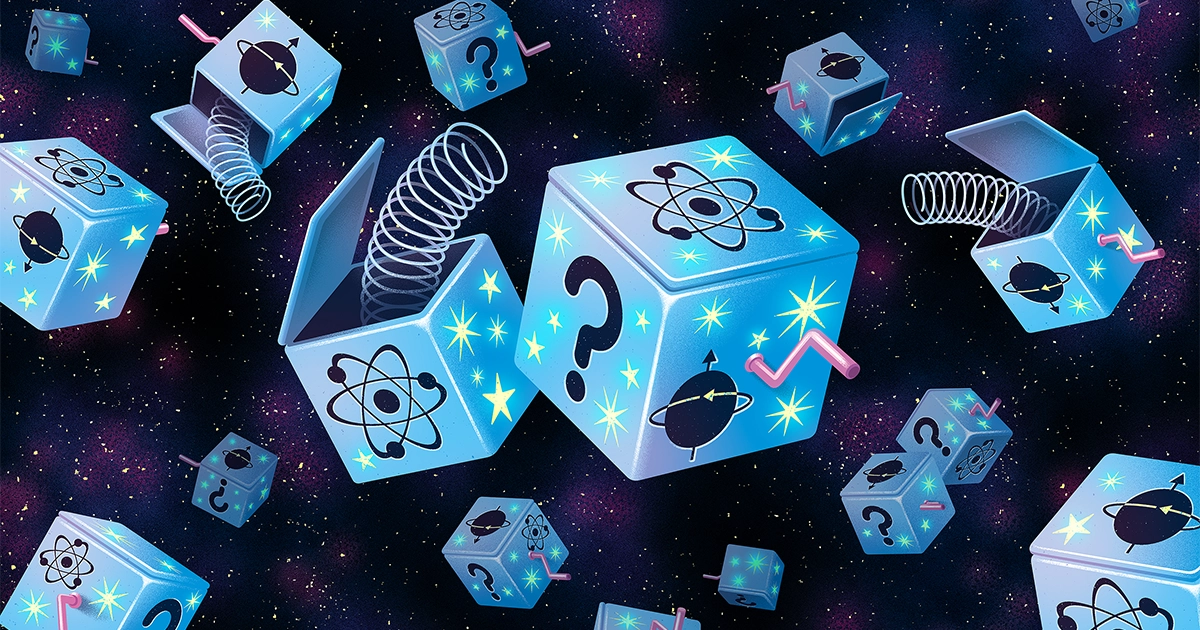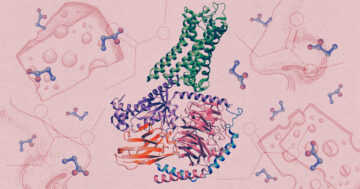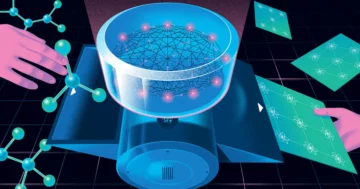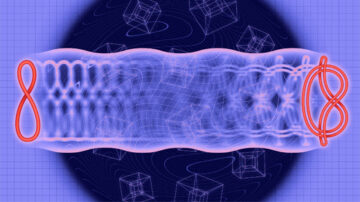
Introduction
The end is brutal for electrons hurtling at 99.9999999% of the speed of light through SLAC National Accelerator Laboratory’s two-mile-long beam pipe: a final slam into End Station A. In the late 1960s and early ’70s, such collisions broke apart protons and neutrons to reveal the elementary particles that make them up. The discovery won the experiment’s leader a Nobel Prize. “End Station A is this hallowed ground at SLAC,” said the physicist Timothy Nelson.
Walking to the back of the warehouse, past piles of equipment, Nelson pointed at the skeleton of an old experiment, beyond the point where the tree-trunk-size pipe of the historic accelerator cut off. It’s there, he said, that a soon-to-be-constructed experiment will see — or quickly rule out — one of the most popular new candidates for dark matter.
Almost a century ago, the Swiss astrophysicist Fritz Zwicky described a galaxy cluster that appeared to rotate too fast to be held together by its visible mass. He proposed that invisible matter was lending its gravity to the situation. The evidence has grown and grown, and researchers now believe that 85% of the universe’s matter is hidden. But the mystery of dark matter’s identity has endured.
For decades, researchers focused on two candidate particle types: weakly interacting massive particles (WIMPs) and axions. These are the simplest formulations for dark matter, and each type of particle would also elegantly solve other physics mysteries. But after roughly 40 years of vain searches for these particles — searches that have almost entirely ruled out the chance that dark matter is made of ordinary WIMPs — physicists have become far more open-minded about what dark matter might be. Maybe dark matter is not simple at all. It could, some suggest, comprise a whole family of particles, as does visible matter.
“The most common hypothesis is that this is somehow simple. Why on earth should we expect that?” said Philip Schuster, a theoretical physicist at Stanford University. “That is not what nature has been trying to tell us for the last 200 years.”
Move away from the WIMP or axion paradigms, and you probably have to give up on the idea that dark matter consists of a single type of particle. Instead, new models involve a bevy of extraordinarily lightweight entities, sometimes called feebly interacting particles. Today’s dark matter hunters are especially excited by two categories of these particles: “light dark matter” and “ultralight dark matter.” Light dark matter can be thought of as lighter variations on WIMPs, while ultralight dark matter is made of even lighter axions.
Introduction
With whole families of lighter-weight, more feebly interacting dark matter candidates being floated, multitudes of smaller, faster experiments are being developed all over the world to look for them.
In 2019, the Department of Energy launched its Dark Matter New Initiatives program to fund research into experiments that could reach their conclusions quickly — in years instead of the decades required by traditional dark matter detection efforts. Today, a number of these projects are ready to begin construction. Experiments targeting different chunks of the space of possibilities are also under development in Europe and Asia.
“If you go back to the way particle physics used to be back in the 1920s and ’30s, it was all small-scale efforts, often by universities or private donors, who would support these little efforts that ended up revolutionizing the field,” Schuster said. “And coming out of the Second World War, the operation shifted toward large-scale, big projects. Small experimental efforts kind of just withered away.”
Schuster and Natalia Toro, also a Stanford physicist, are part of the effort to find the needle — or needles — inside the haystack of hidden particle possibilities.
“There’s this lower-mass range of dark matter that has very similar physics,” Toro said. “Very theoretically reasonable and accessible experimentally. We just haven’t tried turning over those stones. We probably should.”
WIMPs and Axions
WIMPs, which could range from about one to 100,000 times the mass of a proton, would match up neatly with a primordial origin story. They have the correct masses and interaction strengths to have formed abundantly during the Big Bang before annihilating each other at the right rate to become the leftover dark matter inferred in the universe today, a so-called thermal relic.
WIMPs also became a dark matter darling because of the “WIMP miracle”: Their hypothesized mass range and interactions fit the profile of one of the particles predicted by supersymmetry, an appealing hypothetical extension of the known elementary particles.
Introduction
Since the 1990s, experiments have been looking for signs of WIMPs occasionally interacting with protons and neutrons via the weak force. But these searches have come up empty. This means WIMPs would have to interact via the weak force even more feebly than expected. At some point, their interaction strength becomes too low to match the thermal-relic model.
While the search for WIMPs isn’t over, there are not many places left to look. Detectors have become so effective at finding weakly interacting bits of matter that they’re effectively blinded by all the neutrinos coming from the sun, Toro said. “So that’s kind of the end of the WIMP detection era.”
Axions, the other early favorite, are so lightweight that they behave more like waves than particles, similar to our understanding of massless particles such as photons. These candidate particles achieve their own particle-physics miracle, solving the “strong CP” problem. In brief, the laws of particle physics do not explain why the strong force — which holds together atomic nuclei — behaves the same when the charge and “parity” of particles are inverted. This “CP symmetry” points to missing physics. Axions were introduced as a way to ensure symmetry via a tiny force field that stabilizes the strong interactions.
For decades, experiments have searched for axions, albeit at a snail’s pace. The first-generation detectors needed to take long measurements to distinguish between noise and the muffled signal of potential axion interactions. As a result, only a small slice of the axion mass range has been explored. But so far, no axions.
Lighter Dark Matter
By around 2008, the notion of a dark matter particle similar to a WIMP, but smaller, began to emerge. For physicists, this “light dark matter” is akin to seeing a familiar face in a foreign land: The proposed particles exist in a range of masses similar to those of ordinary matter — electron- to proton-size. (A proton weighs the same as about 1,800 electrons.)
But once a feebly interacting particle’s mass drops below about the mass of a proton, it couldn’t have collided and annihilated so easily in the early universe. So, to match the thermal relic, light dark matter requires the existence of at least one unknown force that would affect the dark matter particles.
Every force of nature is mediated by a force-carrying particle. The particle that mediates the hypothetical force associated with light dark matter falls in a class of “portal particles” that bridge the gap between ordinary matter and dark matter. According to Toro, “light” portal particles would interact with light dark matter and very weakly with ordinary matter. One popular candidate is a dark photon, a direct analogue of the familiar photon. Other portals are possible too, such as Higgs-like particles or force carriers that have no known analogue.
Introduction
If or when SLAC’s planned project, the Light Dark Matter Experiment (LDMX), receives funding — a decision from the Department of Energy is expected in the next year or so — it will scan for light dark matter. The experiment is designed to accelerate electrons toward a target made of tungsten in End Station A. In the vast majority of collisions between a speeding electron and a tungsten nucleus, nothing interesting will happen. But rarely — on the order of once every 10,000 trillion hits, if light dark matter exists — the electron will instead interact with the nucleus via the unknown dark force to produce light dark matter, significantly draining the electron’s energy.
That 10,000 trillion is actually the worst-case scenario for light dark matter. It’s the lowest rate at which you can produce dark matter to match thermal-relic measurements. But Schuster says light dark matter might arise in upward of one in every 100 billion impacts. If so, then with the planned collision rate of the experiment, “that’s an inordinate amount of dark matter that you can produce.”
LDMX will need to run for three to five years, Nelson said, to definitively detect or rule out thermal relic light dark matter.
Ultralight Dark Matter
Other dark matter hunters have their experiments tuned for a different candidate. Ultralight dark matter is axionlike but no longer obliged to solve the strong CP problem. Because of this, it can be much more lightweight than ordinary axions, as light as 10 billionths of a trillionth of the electron’s mass. That tiny mass corresponds to a wave with a vast wavelength, as long as a small galaxy. In fact, the mass can’t be any smaller because if it were, the even longer wavelengths would mean that dark matter could not be concentrated around galaxies, as astronomers observe.
Ultralight dark matter is so incredibly minuscule that the dark-force particle needed to mediate its interactions is thought to be massive. “There’s no name given to these mediators,” Schuster said, “because it’s outside of any possible experiment. It has to be there [in the theory] for consistency, but we don’t worry about them.”
The origin story for ultralight dark matter particles depends on the particular theoretical model, but Toro says they would have arisen after the Big Bang, so the thermal-relic argument is irrelevant. There’s a different motivation for thinking about them. The particles naturally follow from string theory, a candidate for the fundamental theory of physics. These feeble particles arise from the ways that six tiny dimensions might be curled up or “compactified” at each point in our 4D universe, according to string theory. “The existence of light axionlike particles is strongly motivated by many kinds of string compactifications,” said Jessie Shelton, a physicist at the University of Illinois, “and it’s something that we should take seriously.”
Rather than trying to create dark matter using an accelerator, experiments looking for axions and ultralight dark matter listen for the dark matter that supposedly surrounds us. Based on its gravitational effects, dark matter seems to be distributed most densely near the Milky Way’s center, but one estimate suggests that even out here on Earth, we can expect dark matter to have a density of almost half a proton’s mass per cubic centimeter. Experiments try to detect this ever-present dark matter using powerful magnetic fields. In theory, the ethereal dark matter will occasionally absorb a photon from the strong magnetic field and convert it into a microwave photon, which an experiment can detect.
Two proposed experiments intend to pursue the dark frequencies: Stanford University’s DM Radio and the ADMX-EFR, or Axion Dark Matter Experiment Extended Frequency Range, at the University of Washington. Both experiments were originally conceived to search for axions, but are now being revised to scan for the lighter variants.
The biggest challenge for both experiments — which also await the Department of Energy’s funding decisions — lies in the faintness of the predicted microwave photons. The tiny signal requires all experimental noise to be removed other than the system’s inherent quantum jitter, a hurdle that researchers think they can overcome.
While these researchers await the faint signals of feeble particles, other dark matter ideas remain in play. Some theoretical physicists are reconsidering a long-sidelined idea that this invisible matter might take the form of primordial black holes created during the Big Bang. One more possibility is that the prevailing theory of gravity isn’t quite right. So far, however, competing gravity theories haven’t garnered much interest.
“At this point,” Schuster said, “let’s be honest, everybody is guessing.”
- SEO Powered Content & PR Distribution. Get Amplified Today.
- PlatoData.Network Vertical Generative Ai. Empower Yourself. Access Here.
- PlatoAiStream. Web3 Intelligence. Knowledge Amplified. Access Here.
- PlatoESG. Carbon, CleanTech, Energy, Environment, Solar, Waste Management. Access Here.
- PlatoHealth. Biotech and Clinical Trials Intelligence. Access Here.
- Source: https://www.quantamagazine.org/dogged-dark-matter-hunters-find-new-hiding-places-to-check-20240507/
- :has
- :is
- :not
- :where
- ][p
- $UP
- 000
- 1
- 10
- 100
- 1920s
- 200
- 2008
- 2019
- 40
- 800
- a
- About
- accelerate
- accelerator
- accessible
- According
- Achieve
- actually
- affect
- After
- ago
- albeit
- All
- almost
- also
- amount
- an
- analogue
- and
- annihilated
- any
- apart
- appealing
- appeared
- ARE
- argument
- arise
- arisen
- around
- AS
- asia
- associated
- At
- await
- away
- back
- bang
- based
- BE
- Beam
- became
- because
- become
- becomes
- been
- before
- began
- begin
- behave
- being
- believe
- below
- between
- Beyond
- Big
- Big Bang
- Biggest
- Billion
- bits
- Black
- both
- BRIDGE
- Broke
- but
- by
- called
- CAN
- candidate
- candidates
- carriers
- categories
- Center
- Century
- challenge
- Chance
- charge
- check
- class
- Cluster
- collision
- come
- coming
- Common
- competing
- conceived
- Concentrated
- Conclusions
- consistency
- consists
- construction
- convert
- correct
- corresponds
- could
- create
- created
- cubic
- Cut
- Dark
- Dark matter
- darling
- decades
- decision
- decisions
- density
- Department
- Department of Energy
- depends
- described
- designed
- detect
- Detection
- developed
- Development
- different
- direct
- discovery
- distinguish
- distributed
- do
- does
- donors
- Dont
- Drops
- during
- each
- Early
- Early Universe
- earth
- easily
- Effective
- effectively
- effects
- effort
- efforts
- electrons
- elementary
- emerge
- empty
- end
- ended
- energy
- entirely
- entities
- equipment
- Era
- especially
- ethereal
- Europe
- Even
- Every
- everybody
- evidence
- excited
- exist
- existence
- exists
- expect
- expected
- experiment
- experimental
- experiments
- Explain
- Explored
- extended
- extension
- extraordinarily
- Face
- fact
- faint
- Falls
- familiar
- families
- family
- far
- FAST
- faster
- Favorite
- field
- Fields
- final
- Find
- finding
- fit
- five
- focused
- follow
- For
- Force
- foreign
- form
- formed
- formulations
- Frequency
- from
- fund
- fundamental
- funding
- Galaxies
- Galaxy
- gap
- garnered
- Give
- given
- Go
- gravitational
- gravity
- Ground
- grown
- guessing
- Half
- happen
- harvard
- Have
- he
- Held
- here
- Hidden
- hiding
- historic
- Hits
- holds
- honest
- However
- HTTPS
- hurdle
- idea
- ideas
- Identity
- if
- illinois
- Impacts
- in
- incredibly
- inferred
- inherent
- inside
- instead
- intend
- interact
- interacting
- interaction
- interactions
- interest
- interesting
- into
- introduced
- invisible
- involve
- IT
- ITS
- just
- Kind
- kinds
- known
- Land
- large-scale
- Last
- Late
- launched
- Laws
- leader
- least
- left
- Leftover
- lending
- lies
- light
- lighter
- lightweight
- like
- listen
- little
- Long
- longer
- Look
- looking
- Low
- lowest
- made
- magazine
- Magnetic field
- Majority
- make
- many
- Mass
- masses
- massive
- Match
- Matter
- maybe
- mean
- means
- measurements
- might
- miracle
- missing
- model
- models
- more
- most
- Most Popular
- Motivation
- much
- multitudes
- Mystery
- name
- National
- naturally
- Nature
- Near
- neatly
- Need
- needed
- neutrinos
- neutrons
- New
- next
- no
- nobel
- nobel prize
- Noise
- nothing
- Notion
- now
- number
- obliged
- observe
- occasionally
- of
- off
- often
- Old
- on
- once
- ONE
- only
- operation
- or
- order
- ordinary
- Origin
- originally
- Other
- our
- out
- outside
- over
- Overcome
- own
- Pace
- paradigms
- part
- particle
- particular
- past
- per
- Photons
- physicist
- Physics
- pipe
- Places
- planned
- plato
- Plato Data Intelligence
- PlatoData
- Play
- Point
- points
- Popular
- Portal
- possibilities
- possibility
- possible
- potential
- powerful
- predicted
- prevailing
- private
- prize
- probably
- Problem
- produce
- Profile
- Program
- project
- projects
- proposed
- protons
- pursue
- Quantamagazine
- Quantum
- quickly
- quite
- range
- rarely
- Rate
- reach
- ready
- reasonable
- receives
- remain
- Removed
- required
- requires
- research
- researchers
- result
- reveal
- Revolutionizing
- right
- roughly
- Rule
- ruled
- Run
- Said
- same
- says
- scan
- scenario
- Search
- searches
- Second
- Second world war
- see
- seeing
- seems
- seriously
- shifted
- should
- Signal
- signals
- significantly
- Signs
- similar
- Simple
- simplest
- single
- situation
- Slice
- small
- smaller
- So
- so Far
- SOLVE
- Solving
- some
- somehow
- something
- sometimes
- Space
- speed
- stanford
- Stanford university
- station
- Stones
- Story
- strength
- strengths
- String
- strong
- such
- suggest
- Suggests
- Sun
- support
- Swiss
- Take
- Target
- targeting
- tell
- than
- that
- The
- the world
- their
- Them
- then
- theoretical
- theoretically
- theory
- There.
- thermal
- These
- they
- Think
- Thinking
- this
- those
- thought
- three
- Through
- times
- tiny
- to
- today
- today’s
- together
- too
- toward
- traditional
- tried
- Trillion
- try
- trying
- tuned
- Turning
- two
- type
- types
- under
- understanding
- Universe
- Universities
- university
- university of washington
- unknown
- upward
- us
- used
- using
- vain
- variants
- variations
- Vast
- very
- via
- visible
- war
- Warehouse
- was
- washington
- Wave
- wavelengths
- waves
- Way..
- ways
- we
- webp
- weighs
- were
- What
- when
- which
- while
- WHO
- whole
- why
- will
- with
- Won
- world
- worry
- would
- year
- years
- you
- zephyrnet










